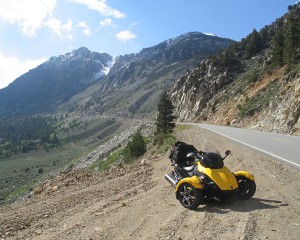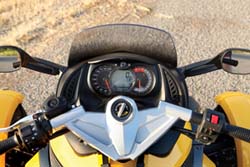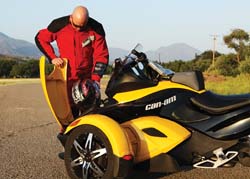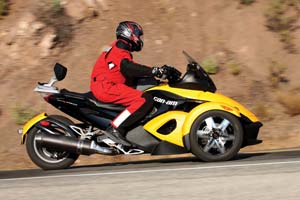by Troy Siahaan

The wild vehicle you see before you is the 2008 Can-Am Spyder, which parent company Bombardier is using to bring the Can-Am name to the road, and is hoping will revolutionize the powersports industry. You may remember Can-Am. Its motocross and enduro bikes dominated the racing scene in the early ’70s before Bombardier decided to diversify its recreational products, drastically reducing investment dollars in Can-Am and setting the scene for what would eventually be the demise of the brand. Times change, and for 2006 Bombardier brought back the Can-Am name on its all-terrain vehicles, and now for 2008 the Can-Am name is back on a road-going vehicle.
If you remember the original Can-Am motorcycles and are reading this sentence, Can-Am is marketing the Spyder with you in mind-more mature riders who still want to sport tour, but feel they have responsibilities that might be jeopardized by a traditional motorcycle. No surprise it’s also targeting the Spyder at new riders who want the open-air experience of a motorcycle but are intimidated by all the controls and tippiness of a two-wheeler. For them, the Spyder combines the best of both worlds: The thrill of the open road and the peace of mind that comes with the stability of a third wheel.
OK, so what is it, exactly? Think of the Spyder as a cross among a sports car, snowmobile and motorcycle, but whatever you do, don’t call it a trike-any relationship to poorer-handling, sometimes unstable vehicles with two wheels in back is purely in the number of wheels. The Spyder utilizes two 14-inch wheels in the front with a sports-carlike double A-arm suspension, while the rear 15-inch wheel is attached to a motorcyclelike swingarm with a single shock. This layout handles more like a Ferrari than any tricycle.

At the heart of the Spyder is a 998cc Rotax engine derived from the same 60-degree V-twin found in the Aprilia Mille, retuned for torque and regeared to accommodate the extra weight of the Spyder. Interestingly, it’s mounted with the crankshaft running transversely and the cylinders in-line with the chassis rather than across the frame. Can-Am claims the Spyder makes 106 horsepower and 77 lb-ft of torque at the rear (driven) wheel, all transferred there via belt final drive.
Besides looking like a snowmobile on wheels, the Spyder’s seating position is also very snowmobile-esque. The first thing I noticed as I reached for the brake lever was that it isn’t there! The triple-disc, anti-lock brakes are all linked and are operated by the right foot lever-the rear brake on a traditional motorcycle-leaving the space where a front brake lever would normally be vacant. Coming to a stop the first few times was a little unnerving but I soon adjusted. Can-Am claims the system works similarly to the brakes in a car, which would have made sense‚ if we were in a car! Thankfully, the clutch and gear selector were in their normal motorcycle positions.

On the road the preproduction Spyder feels like a convertible sports car with a funky seating position, yet it was still comfortable for the entire ride. Before I could take my first spin I had to back out of the parking space with the gear-driven reverse, operated by a toggle switch on the left handlebar. Once moving, the Rotax engine really comes on strong and provides motorcyclelike acceleration, assuming the traction control doesn’t kick in-but more on that later. Of note is the significant amount of heat from the radiator that hits the rider’s right leg. The radiator on the Spyder is positioned to the right of the engine to accommodate the oil cooler on the left, and the body cowling is shaped to act as a duct to feed the radiator cool air while moving. Unfortunately, that also means that it dumps hot air straight on the rider’s leg. It wasn’t a big issue while wearing riding apparel
and my leg didn’t get burned, but it was definitely noticeable.
Florida isn’t known for its abundance of twisty roads, but on those we found I felt that the power-assisted steering was very precise and reacted to the slightest bar input. Unlike a motorcycle, of course, the Spyder steers into turns like a car-left to go left and right to go right. The Spyder also features what Can-Am calls VSS, or Vehicle Stability System-better known as traction control. Can-Am partnered with Bosch to create one of the most impressive systems on the market.
Sensors at each wheel monitor wheel speed, and there’s also a steering angle sensor, yaw sensor and engine management sensor. What do they all do? By monitoring wheel speed, etc., basically the system makes sure that you don’t defy the laws of physics. If all three wheels are moving at the same speed the system is passive (although it will allow the rear wheel to spin faster than the front in a straight line up to about 35 mph, or if it detects that the vehicle is turning). During sudden turns the steering angle sensor determines if the speed is safe for the radius of the turn, and the yaw sensor predicts whether either of the front wheels will come off the ground. If any of those parameters is exceeded, the system will respond by first retarding the ignition, then it’ll cut off the fuel supply to the engine, and if that’s still not enough, the brakes are applied to the outside wheel. The system is always on-there is no “off” button -which is great for the average consumer but a downer for those looking for more sport in their touring.

The “ride” of the Spyder feels like that of a car. Bumps are absorbed with little input to the rider (or is that driver?), whereas on a motorcycle every imperfection is usually transferred through the suspension. For example, on the highway at night you’ll notice that a motorcycle’s headlight will “bounce” over the slightest bump. Not on the Spyder.
Can-Am is really going out on a limb with the Spyder. Is it an answer to a question that nobody has asked, or is it the next big thing to hit the powersports industry? Ultimately, public reaction and sales are the big question marks. Part of the lure of being on two wheels is the sensation of lean angles, which the Spyder doesn’t provide. What it does provide is a truly unique experience that really can’t be compared to a bike or a car, and Can-Am will reportedly offer accessories such as locking luggage and taller windscreens for long-distance travel. At $14,999 for the base model and $16,499 for the electronic shifting model (√† la Yamaha FJR1300AE) available later this year, time will tell if the gamble pays off.
Related Articles:
2010 Can-Am Spyder RT-S Road Test








I just bought 2009 can -am spyder 5 speed automatic. I had a full hip replacement and I had to sell my 2013 Harley sportster because I kept dropping it I tried a new HD freewheeler trike but felt like it was going to tip over when going around the turns , the guys there told me to try a can-am which I did and I fell in love with it I didnt want to go brand new so I bought the 2009 from a dealer I LOVE MY CAN-AM .my husband has a HD soft tail and I can keep up no problem plus going around the turns is great I am looking to get a new one now cause we take long trips but again I LOVE IT its all in what is good for you as a rider